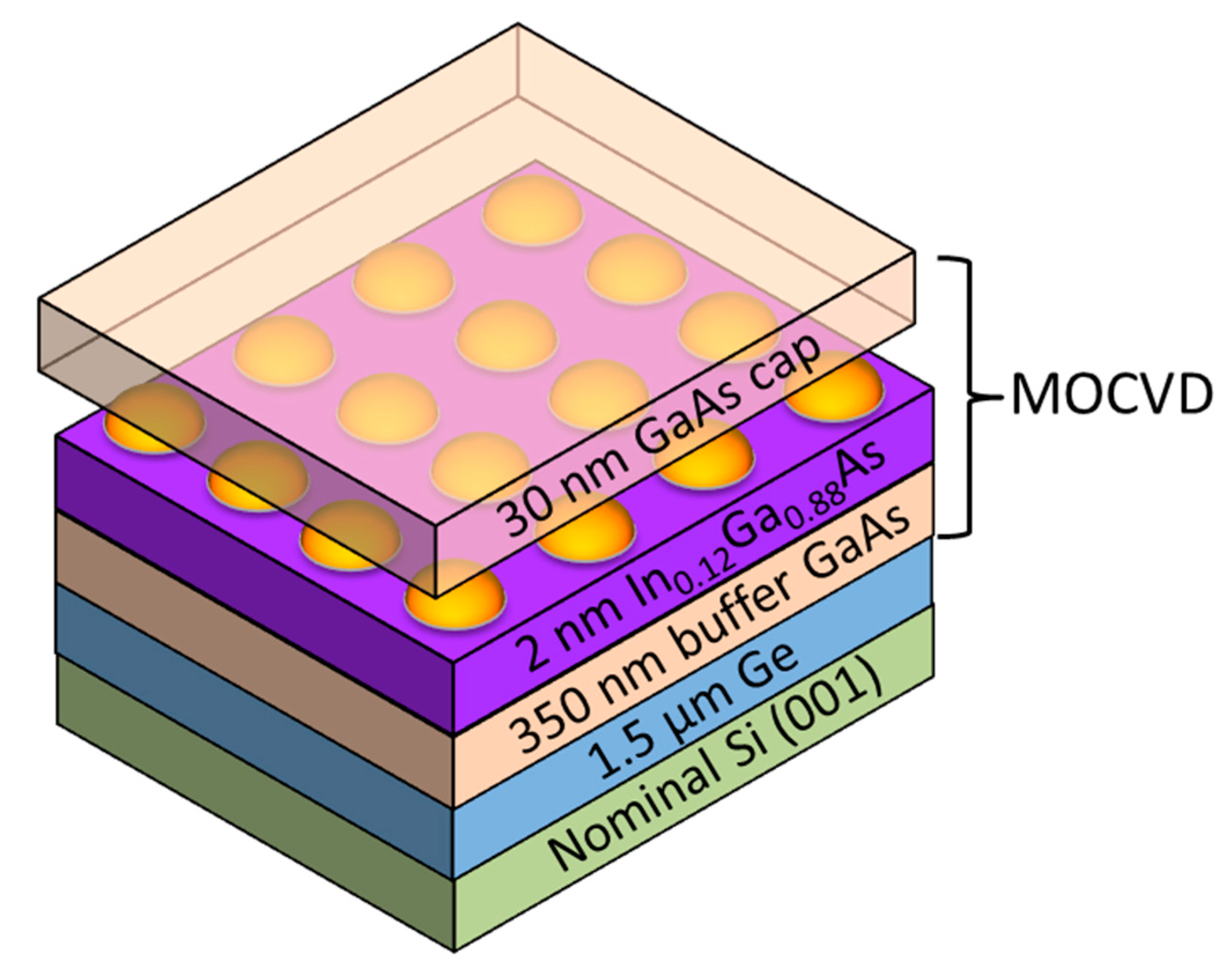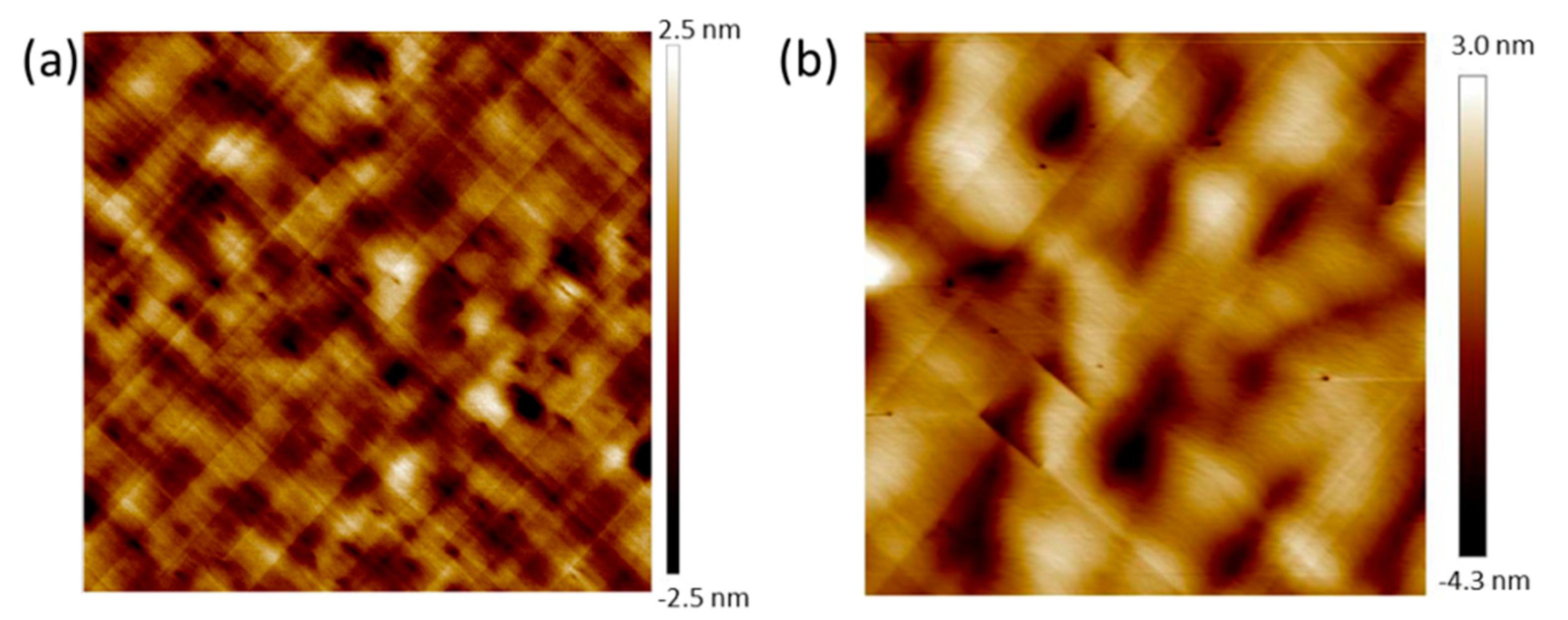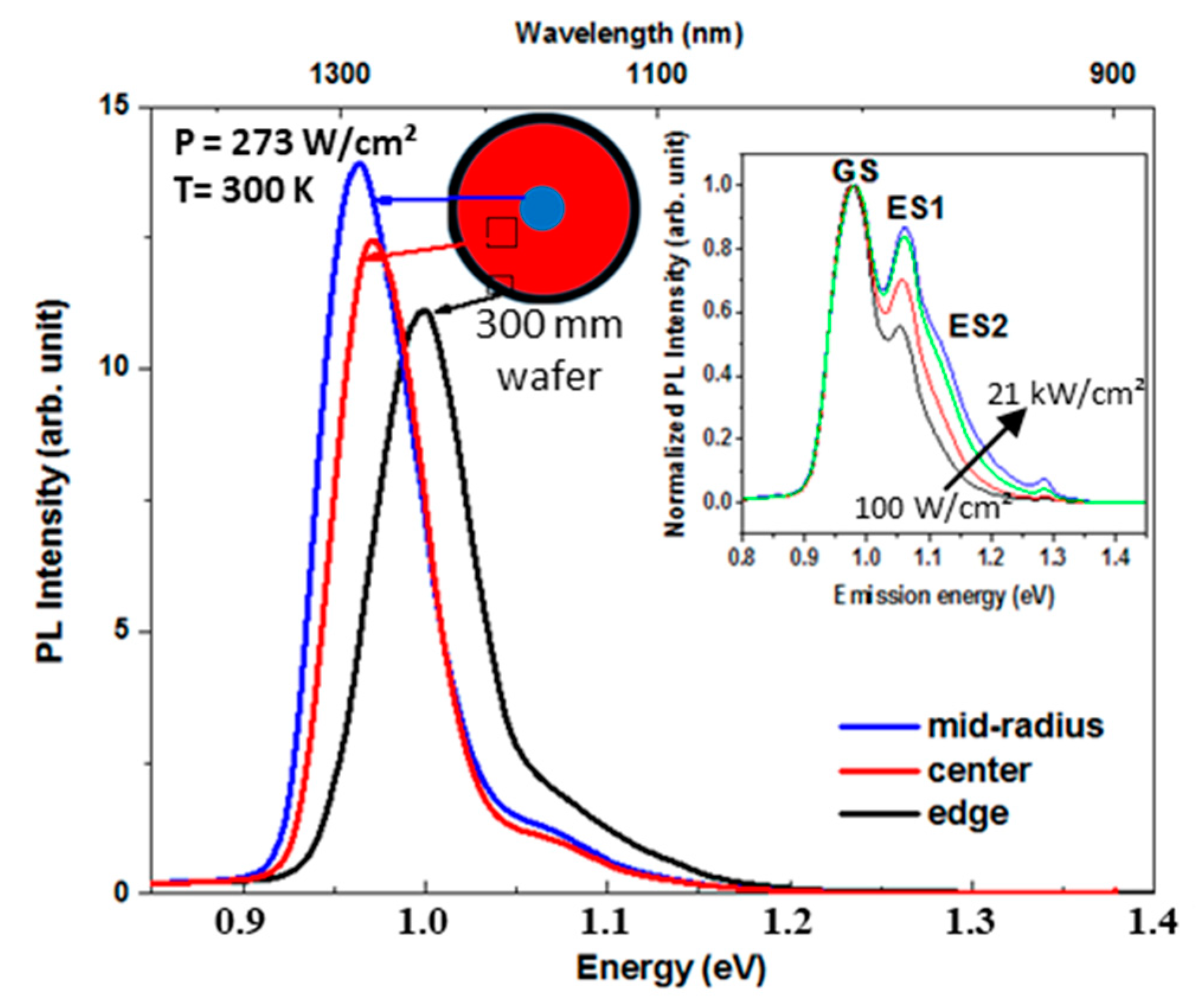O-Band Emitting InAs Quantum Dots Grown by MOCVD on a 300 mm Ge-Buffered Si (001) Substrate
Abstract
1. Introduction
2. Experiments
3. Results and Discussion
4. Conclusions
Author Contributions
Funding
Conflicts of Interest
References
- Roelkens, G.; Abassi, A.; Cardile, P.; Dave, U.; De Groote, A.; De Koninck, Y.; Dhoore, S.; Fu, X.; Gassenq, A.; Hattasan, N.; et al. III-V-on-silicon photonic devices for optical communication and sensing. Photonics 2015, 2, 969–1004. [Google Scholar] [CrossRef]
- Mi, Z.; Yang, J.; Bhattacharya, P.; Qin, G.; Ma, Z. High-performance quantum dot lasers and integrated optoelectronics on Si. Proc. IEEE 2009, 97, 1239–1249. [Google Scholar] [CrossRef]
- Yodo, T.; Tamura, M.; Saitoh, T. Relationship between the optical and structural properties in GaAs heteroepitaxial layers grown on Si substrates. J. Cryst. Growth 1994, 141, 331–342. [Google Scholar] [CrossRef]
- Lourdudoss, S. Heteroepitaxy and selective area heteroepitaxy for silicon photonics. Curr. Opin. Solid State Mater. Sci. 2012, 16, 91–99. [Google Scholar] [CrossRef]
- Kroemer, H. Polar-on-nonpolar epitaxy. J. Cryst. Growth 1987, 81, 193–204. [Google Scholar] [CrossRef]
- Ward, T.; Sánchez, A.M.; Tang, M.; Wu, J.; Liu, H.; Dunstan, D.J.; Beanland, R. Design rules for dislocation filters. J. Appl. Phys. 2014, 116, 63508. [Google Scholar] [CrossRef]
- Yang, V.K.; Groenert, M.; Leitz, C.W.; Pitera, A.J.; Currie, M.T.; Fitzgerald, E.A. Crack formation in GaAs heteroepitaxial films on Si and SiGe virtual substrates. J. Appl. Phys. 2003, 93, 3859–3865. [Google Scholar] [CrossRef]
- Gérard, J.M.; Cabrol, O.; Sermage, B. InAs quantum boxes: Highly efficient radiative traps for light emitting devices on Si. Appl. Phys. Lett. 1996, 68, 3123–3125. [Google Scholar] [CrossRef]
- Hartmann, J.M.; Aubin, J. Assessment of the growth/etch back technique for the production of Ge strain-relaxed buffers on Si. J. Cryst. Growth 2018, 488, 43–50. [Google Scholar] [CrossRef]
- Hino, Y.; Ozaki, N.; Ohkouchi, S.; Ikeda, N.; Sugimoto, Y. Growth of InAs/GaAs quantum dots with central emission wavelength of 1.05 μm using In-flush technique for broadband near-infrared light source. J. Cryst. Growth 2013, 378, 501–505. [Google Scholar] [CrossRef]
- Ilahi, B.; Salem, B.; Aimez, V.; Sfaxi, L.; Maaref, H.; Morris, D. Post-growth engineering of InAs/GaAs quantum dots’ band-gap using proton implantation and annealing. Nanotechnology 2006, 17, 3707–3709. [Google Scholar] [CrossRef]
- Bogumilowicz, Y.; Hartmann, J.M.; Rochat, N.; Salaun, A.; Martin, M.; Bassani, F.; Baron, T.; David, S.; Bao, X.-Y.; Sanchez, E. Threading dislocations in GaAs epitaxial layers on various thickness Ge buffers on 300 mm Si substrates. J. Cryst. Growth 2016, 453, 180–187. [Google Scholar] [CrossRef]
- Hartmann, J.M.; Abbadie, A.; Barnes, J.P.; Fédéli, J.M.; Billon, T.; Vivien, L. Impact of the H2 anneal on the structural and optical properties of thin and thick Ge layers on Si; Low temperature surface passivation of Ge by Si. J. Cryst. Growth 2010, 312, 532–541. [Google Scholar] [CrossRef]
- Bogumilowicz, Y.; Hartmann, J.M.; Cipro, R.; Alcotte, R.; Martin, M.; Bassani, F.; Moeyaert, J.; Baron, T.; Pin, J.B.; Bao, X.; et al. Anti-phase boundaries-Free GaAs epilayers on ‘quasi-nominal’ Ge-buffered silicon substrates. Appl. Phys. Lett. 2015, 107, 212105. [Google Scholar] [CrossRef]
- Eisele, H.; Lenz, A.; Heitz, R.; Timm, R.; Dähne, M.; Temko, Y.; Suzuki, T.; Jacobi, K. Change of InAs/GaAs quantum dot shape and composition during capping. J. Appl. Phys. 2008, 104, 124301. [Google Scholar] [CrossRef]
- Li, K.; Liu, Z.; Tang, M.; Liao, M.; Kim, D.; Deng, H.; Sanchez, A.M.; Beanland, R.; Martin, M.; Baron, T.; et al. O-band InAs/GaAs quantum dot laser monolithically integrated on exact (001) Si substrate. J. Cryst. Growth 2019, 511, 56–60. [Google Scholar] [CrossRef]
- Souaf, M.; Baira, M.; Nasr, O.; Alouane, M.H.H.; Maaref, H.; Sfaxi, L.; Ilahi, B. Investigation of the InAs/GaAs quantum dots’ size: Dependence on the strain reducing layer’s position. Materials 2015, 8, 4699–4709. [Google Scholar] [CrossRef]
- Califano, M.; Harrison, P. Presentation and experimental validation of a single-band, constant-potential model for self-assembled InAs/GaAs quantum dots. Phys. Rev. B 2000, 61, 10959. [Google Scholar] [CrossRef]
- Salhi, A.; Alshaibani, S.; Ilahi, B.; Alhamdan, M.; Alyamani, A.; Albrithen, H.; El-Desouki, M. Tailoring the optical properties of InAs/GaAs quantum dots by means of GaAsSb, InGaAs and InGaAsSb strain reducing layers. J. Alloys Compd. 2017, 714, 331–337. [Google Scholar] [CrossRef]
- Vurgaftman, I.; Meyer, J.R.; Ram-Mohan, L.R. Band parameters for III–V compound semiconductors and their alloys. J. Appl. Phys. 2001, 89, 5815–5875. [Google Scholar] [CrossRef]
- Sato, M.; Horikoshi, Y. Effect of indium replacement by gallium on the energy gaps of InAs/GaAs thin-layer structures. J. Appl. Phys. 1991, 69, 7697–7702. [Google Scholar] [CrossRef]
- Drozdov, Y.N.; Baidus, N.V.; Zvonkov, B.N.; Drozdov, M.N.; Khrykin, O.I.; Shashkin, V.I. Segregation of indium in InGaAs/GaAs quantum wells grown by vapor-phase epitaxy. Semiconductors 2003, 37, 194–199. [Google Scholar] [CrossRef]
- Joyce, P.B.; Krzyzewski, T.J.; Bell, G.R.; Jones, T.S.; Malik, S.; Childs, D.; Murray, R. Effect of growth rate on the size, composition, and optical properties of InAs/GaAs quantum dots grown by molecular-beam epitaxy. Phys. Rev. B 2000, 62, 10891. [Google Scholar] [CrossRef]
- Bruls, D.M.; Vugs, J.W.A.M.; Koenraad, P.M.; Salemink, H.W.M.; Wolter, J.H. Determination of the shape and indium distribution of low-growth-rate InAs quantum dots by cross-sectional scanning tunneling microscopy. Appl. Phys. Lett. 2002, 81, 1708. [Google Scholar] [CrossRef]








Publisher’s Note: MDPI stays neutral with regard to jurisdictional claims in published maps and institutional affiliations. |
© 2020 by the authors. Licensee MDPI, Basel, Switzerland. This article is an open access article distributed under the terms and conditions of the Creative Commons Attribution (CC BY) license (http://creativecommons.org/licenses/by/4.0/).
Share and Cite
Abouzaid, O.; Mehdi, H.; Martin, M.; Moeyaert, J.; Salem, B.; David, S.; Souifi, A.; Chauvin, N.; Hartmann, J.-M.; Ilahi, B.; et al. O-Band Emitting InAs Quantum Dots Grown by MOCVD on a 300 mm Ge-Buffered Si (001) Substrate. Nanomaterials 2020, 10, 2450. https://doi.org/10.3390/nano10122450
Abouzaid O, Mehdi H, Martin M, Moeyaert J, Salem B, David S, Souifi A, Chauvin N, Hartmann J-M, Ilahi B, et al. O-Band Emitting InAs Quantum Dots Grown by MOCVD on a 300 mm Ge-Buffered Si (001) Substrate. Nanomaterials. 2020; 10(12):2450. https://doi.org/10.3390/nano10122450
Chicago/Turabian StyleAbouzaid, Oumaima, Hussein Mehdi, Mickael Martin, Jérémy Moeyaert, Bassem Salem, Sylvain David, Abdelkader Souifi, Nicolas Chauvin, Jean-Michel Hartmann, Bouraoui Ilahi, and et al. 2020. "O-Band Emitting InAs Quantum Dots Grown by MOCVD on a 300 mm Ge-Buffered Si (001) Substrate" Nanomaterials 10, no. 12: 2450. https://doi.org/10.3390/nano10122450
APA StyleAbouzaid, O., Mehdi, H., Martin, M., Moeyaert, J., Salem, B., David, S., Souifi, A., Chauvin, N., Hartmann, J.-M., Ilahi, B., Morris, D., Ahaitouf, A., Ahaitouf, A., & Baron, T. (2020). O-Band Emitting InAs Quantum Dots Grown by MOCVD on a 300 mm Ge-Buffered Si (001) Substrate. Nanomaterials, 10(12), 2450. https://doi.org/10.3390/nano10122450






